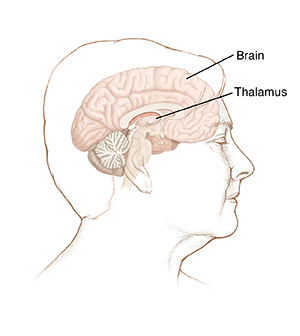Understanding Thalamic Stroke
The thalamus is a complex part of the brain. It sits deep in the center of the brain at the top of the brainstem. The thalamus has 2 halves and is only about the size of walnut. But despite the thalamus’ small size, a stroke there can have a wide range of effects in the body and cause a broad range of symptoms.

What causes thalamic stroke?
Like other types of stroke, thalamic stroke can be caused by a blood clot blocking blood flow to the thalamus (ischemic). Or it can be caused by bleeding from a blood vessel in the thalamus (hemorrhagic).
Symptoms of thalamic stroke
Symptoms of thalamic stroke vary depending on which part of the thalamus was damaged:
-
Muscular weakness or weakness on one side of the body
-
Vision changes
-
Trouble swallowing
-
Decreased level of consciousness
-
Memory loss
-
Burning sensation
-
Trouble with thinking skills, confusion, and impaired judgment
-
Agitation
-
Feeling very sleepy
How is thalamic stroke diagnosed?
A thalamic stroke can be diagnosed with imaging studies, such as:
-
CT scan. CT scan is a test that combines X-rays and computer scans. The result is a detailed picture that can show problems with your blood vessels and organs.
-
MRI. This is a test that lets your healthcare provider see detailed pictures of the inside of your body. MRI combines the use of strong magnets and radio waves to form an MRI image without using X-rays.
Treatment for thalamic stroke
For a thalamic stroke caused by a blood clot, you may be given medicines that dissolve the clot. Or you may have surgery to remove the clot. If the stroke is diagnosed within the first few hours, a medicine called alteplase IV tPA is used to help dissolve the clot and improve blood flow.
For a hemorrhagic stroke in the thalamus, you may need surgery to repair the bleeding blood vessel.
Call 911
Call 911 or go to the emergency room if you have any symptoms of stroke.
B.E. F.A.S.T. is an easy way to remember the signs of a stroke. When you see these signs, you will know that you need to call 911 fast.
B.E. F.A.S.T. stands for:
-
Bis for balance. Sudden loss of balance or coordination, or trouble walking.
-
E is for eyes. Vision changes in one or both eyes.
-
F is for face drooping. One side of the face is drooping or numb. When the person smiles, the smile is uneven.
-
A is for arm weakness. One arm is weak or numb. When the person lifts both arms at the same time, one arm may drift downward.
-
S is for speech difficulty. You may notice slurred speech or difficulty speaking. The person can't repeat a simple sentence correctly when asked.
-
T is for time to dial 911.. If someone shows any of these symptoms, even if they go away, call 911 right away. Make note of the time the symptoms first appeared.